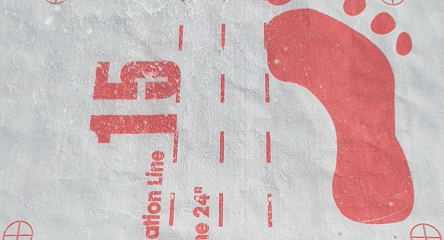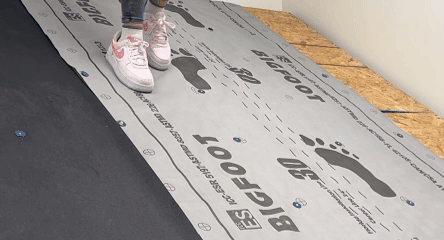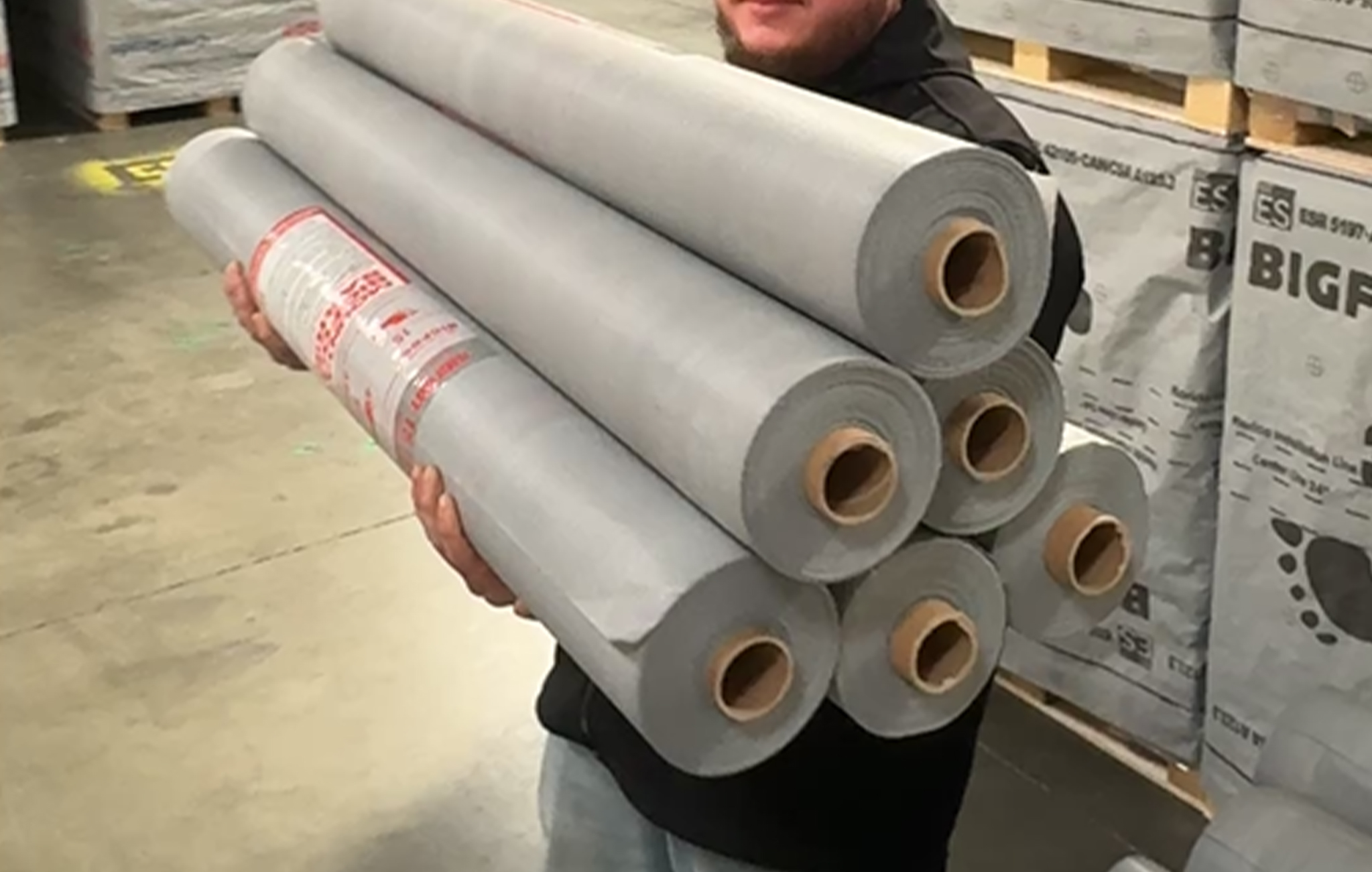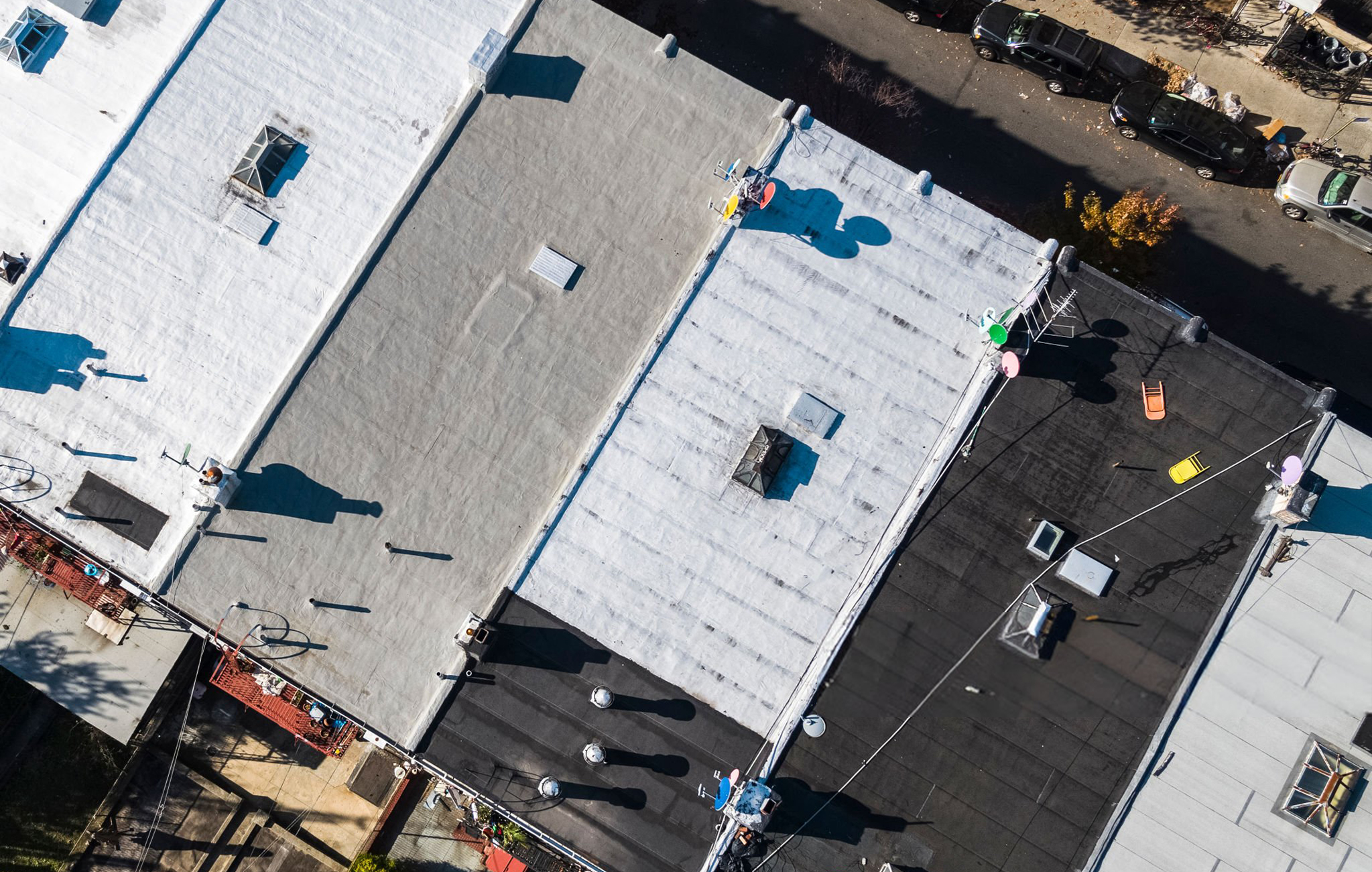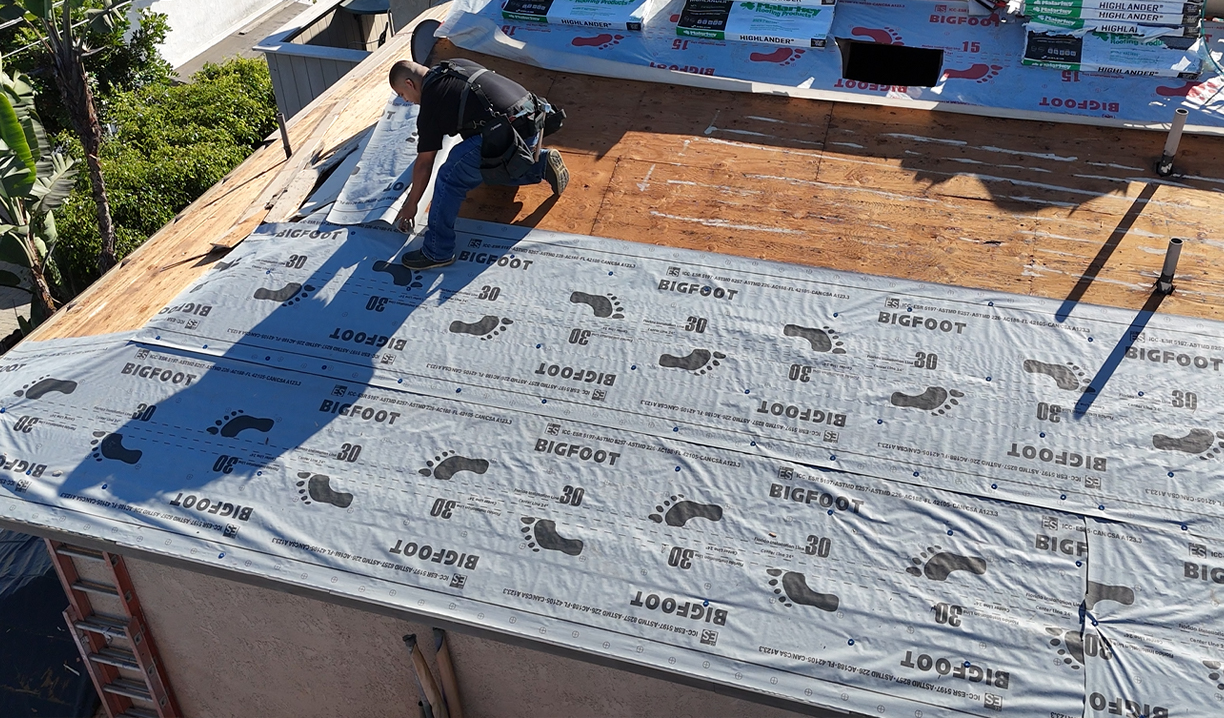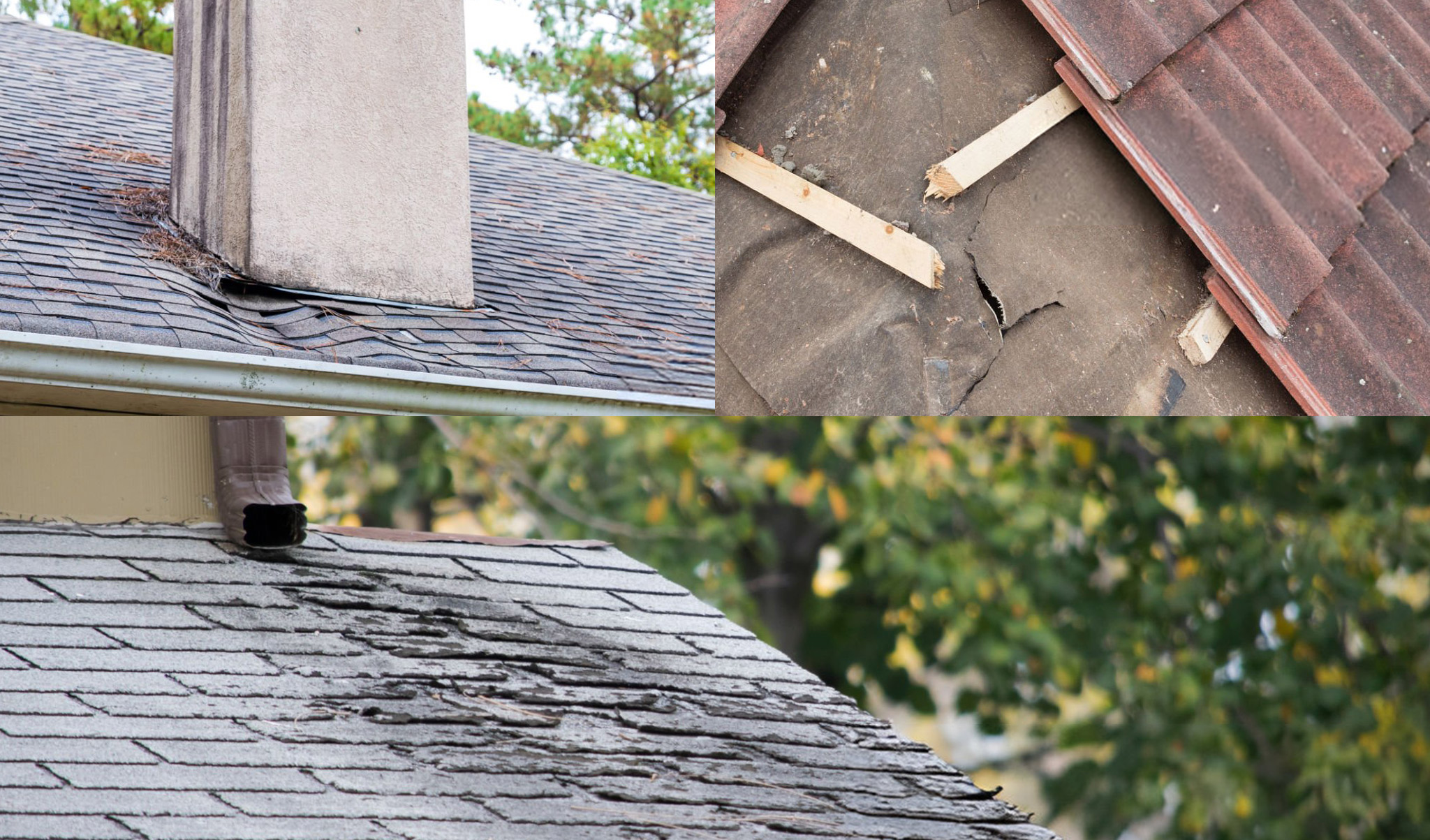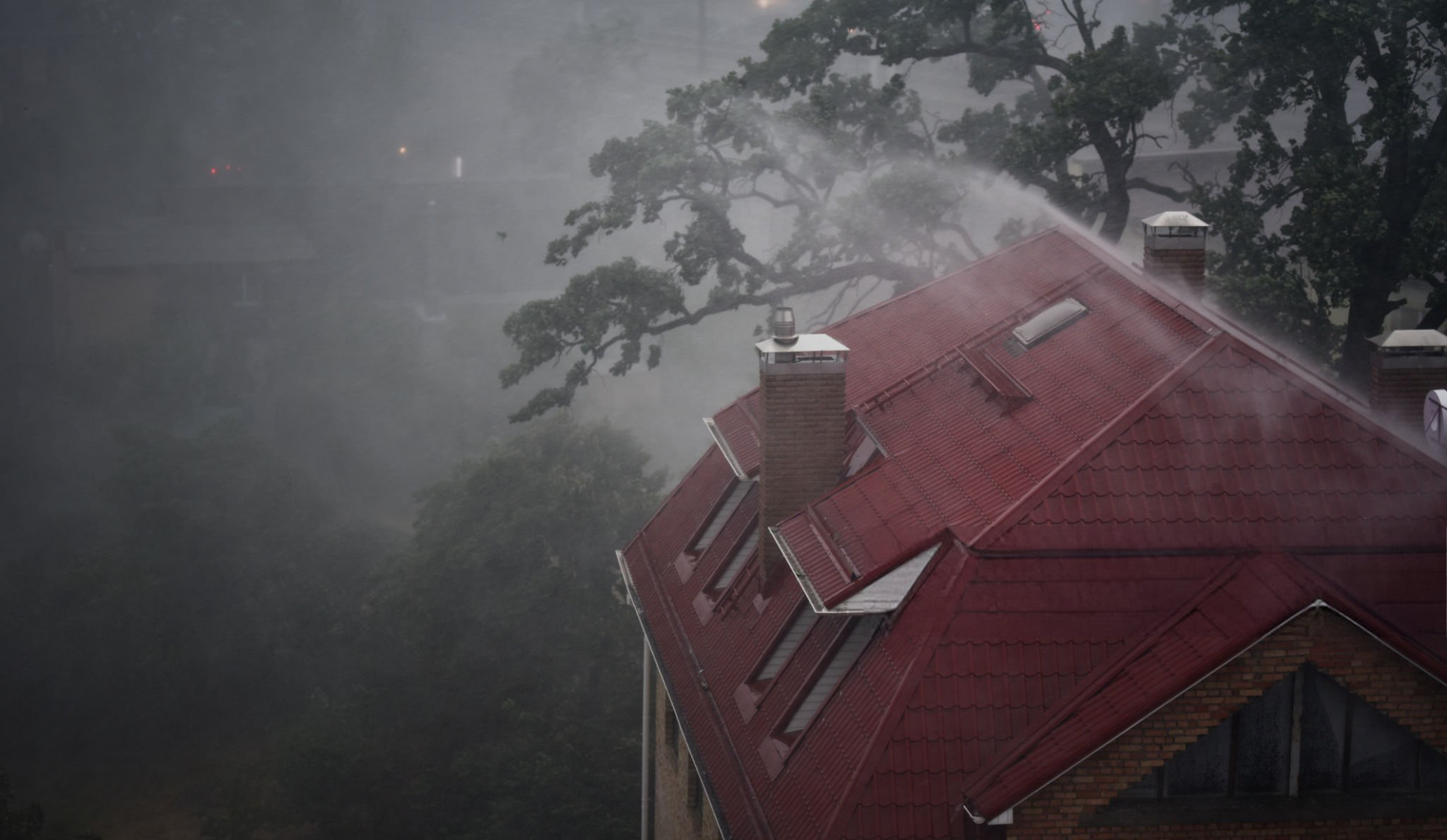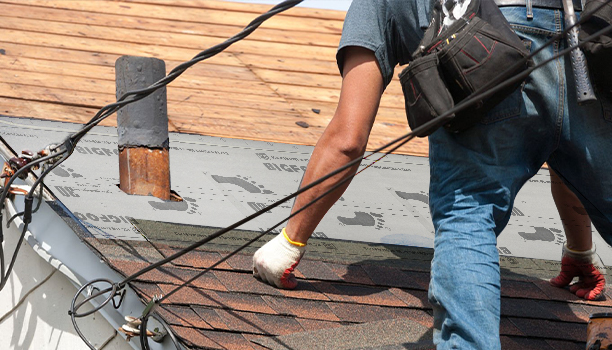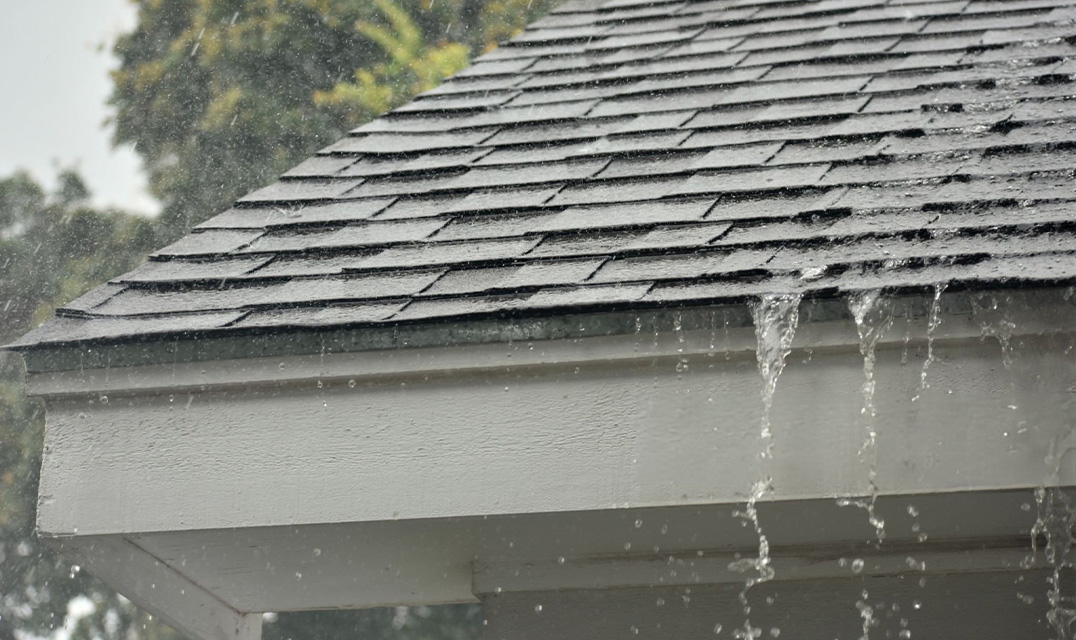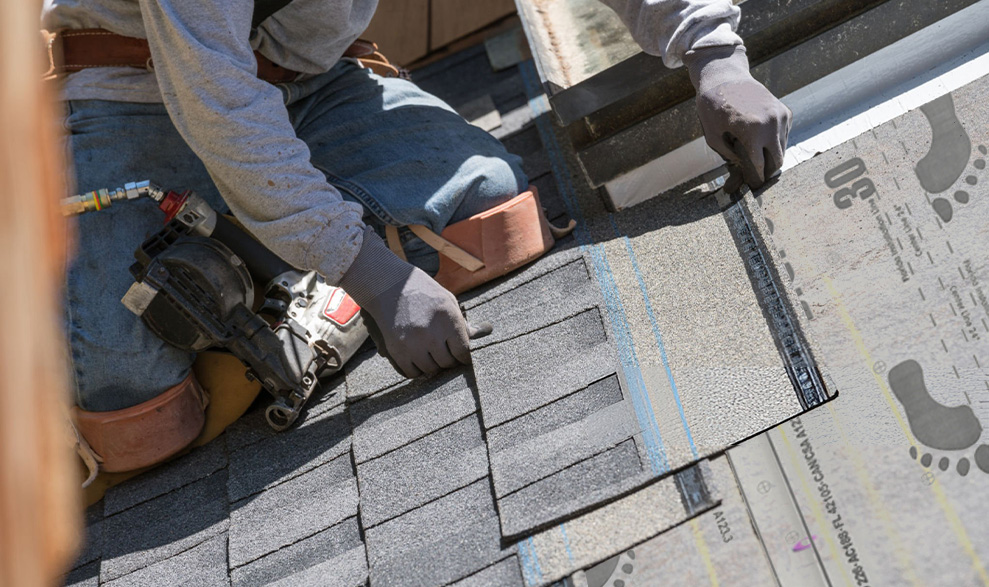Roof Synthetic Underlayment: Durability Shapes a New Guarantee for Building Waterproofing
Recently, with the continuous improvement of the waterproof requirements in the construction industry, roof synthetic underlayment
has gradually become a new favorite in the building waterproofing field due to its excellent durability.
Traditional roof waterproof materials are prone to problems such as aging, cracking, and damage under long - term exposure
to sunlight, rain, temperature changes, and mechanical stress. These problems lead to a decline in waterproof performance and
require frequent repairs or even replacements. However, the new - type roof synthetic underlayment adopts advanced polymer
materials and unique production processes, which greatly enhance the durability of the product.
It is understood that the polymer materials selected for these synthetic underlayments have excellent weather resistance
and can effectively resist the erosion of natural factors such as ultraviolet rays, ozone, and acid rain, slowing down the
aging rate of the materials. At the same time, their unique molecular structure endows the underlayment with excellent
flexibility and tear resistance, enabling it to remain intact and less likely to crack when facing the expansion and contraction
deformation of the roof due to temperature changes.
In terms of the production process
advanced composite technology enables the various layers of materials of the underlayment
to be closely combined, forming a solid whole, which further enhances the durability of the product. In addition, some synthetic
underlayments are added with special anti - aging agents and stabilizers, fundamentally extending the service life of the product.
In practical applications
the durability of roof synthetic underlayment has been fully verified. The roof of Mr. and Mrs. Smith's
house uses a new - type synthetic underlayment. After years of use, it still maintains good waterproof performance, provides
reliable protection for the building, and greatly reduces the later maintenance costs.
Experts said that the high durability of roof synthetic underlayment not only provides a more reliable guarantee for building
waterproofing but also conforms to the concept of sustainable development, reducing the waste of resources and environmental
pollution caused by the frequent replacement of waterproof materials. With the continuous progress of technology and the
further reduction of costs, roof synthetic underlayment is expected to be widely used in more construction projects, promoting
the building waterproofing industry to move towards a new stage of development.
2025-02-07
DETAIL

Innovative Anti-Slip Surface Technology for Roof Synthetic Underlayment Significantly Enhances Construction Safety and Efficiency
Recently, a major breakthrough in anti-slip surface technology for roof synthetic underlayment has brought a new solution to
the construction industry, significantly improving safety and efficiency. This innovative technology not only effectively reduces
the risk of workers slipping during roof operations but also extends the lifespan of roofs by enhancing the durability and stability
of the underlayment.
Technical Highlights: Comprehensive Improvement in Anti-Slip and Safety Performance
Traditional roof underlayment materials are prone to causing worker slips under wet or slippery conditions, increasing construction
risks. The new synthetic underlayment, however, incorporates advanced anti-slip surface treatment technology. Through unique
texture design and material formulation, it significantly increases the friction coefficient. Even in rainy or oily environments, the
underlayment surface provides reliable grip, ensuring safe working conditions for workers.
Additionally, this technology integrates UV resistance, corrosion resistance, and anti-aging properties, allowing the underlayment
to maintain excellent performance even under extreme weather conditions. This not only reduces maintenance costs but also further
enhances the overall safety of roofs.
Wide Range of Applications, Driving High-Quality Development in the Construction Industry
The anti-slip surface technology for roof synthetic underlayment is suitable for various types of building roofs, including residential,
commercial, and industrial buildings. Its lightweight design and easy installation features significantly shorten construction cycles
and reduce labor costs. Moreover, the technology complies with international safety standards, providing construction companies
with a more competitive solution.
Broad Market Prospects, Promoting Green Transformation in the Industry
With the increasing global demand for construction safety and sustainability, the anti-slip surface technology for roof synthetic
underlayment is expected to become a new industry standard. Its eco-friendly materials and energy-saving characteristics align
with the development trends of green building, injecting new momentum into the sustainable development of the construction
industry.
About Us
We, ABP (American Building Products), are a high-tech enterprise dedicated to the research and development of innovative
building materials. We focus on providing safe, efficient, and environmentally friendly roof solutions to global customers. In the
future, we will continue to drive technological innovation, contributing to the safety and sustainable development of the
construction industry.
For more information, please visit our website.
2025-02-06
DETAIL

Roof Synthetic Underlayment: The All - Around Protector of Building Roofs
In today's constantly evolving construction industry, roof synthetic underlayment, as an innovative building material, is providing
all - round protection for various building roofs with its excellent performance and diverse advantages, becoming the focus of
attention in the construction field.
From the Perspective of Material Properties
Roof synthetic underlayment is made from advanced polymer materials and special formulas, featuring outstanding weather resistance.
Whether it is exposed to the sun for a long time, battered by rainstorms, blizzards, or facing extreme temperature changes between
severe cold and heat, it can maintain stable performance and is not prone to aging, cracking, or deformation. For example, the synthetic
underlayment products of BIGFOOT, after rigorous laboratory - simulated environmental tests, can still maintain good waterproof and
tensile properties under simulated extreme climate conditions for consecutive years.
Meanwhile, the waterproof performance of synthetic underlayment is extremely excellent. Its molecular structure is dense, effectively
blocking the penetration of external moisture such as rainwater and snowmelt, forming a solid waterproof barrier. Compared with
traditional waterproof felts, the waterproof effect of synthetic underlayment is more durable and reliable, greatly reducing the risk
of roof leakage.
From the Perspective of Functional Applications
In terms of thermal insulation, roof synthetic underlayment plays an important role. It can effectively block the heat transfer between
indoor and outdoor environments, reducing the heat influx in summer and heat loss in winter, helping buildings achieve better energy
- saving effects.
From the Perspective of Construction and Installation
The installation process of synthetic underlayment is relatively simple and quick. It is lightweight, facilitating handling and construction,
and greatly reducing the labor intensity of construction workers. Moreover, synthetic underlayment is usually installed by self - adhesive
or splicing methods, eliminating the need for complex construction tools and techniques, and effectively shortening the construction
period. When using synthetic underlayment for roof construction, the construction time is reduced by one - third compared to traditional
materials, improving the overall project progress.
At the same time, the flexibility and plasticity of synthetic underlayment enable it to adapt to various roof shapes and structures. Whether
it is a flat roof, pitched roof, or complex irregular - shaped roof, it can achieve a perfect fit, ensuring construction quality and effectiveness.
From the Perspective of Environmental Protection and Sustainability
With the increasing emphasis on environmental protection concepts in the construction industry, the advantages of roof synthetic
underlayment in environmental protection have also received much attention. Many synthetic underlayments are made from recyclable
materials, meeting the requirements of green buildings. After their service life ends, they can be recycled and reused, reducing
environmental pollution. Moreover, the long service life of synthetic underlayment also means reducing the replacement frequency of
building materials, indirectly reducing resource consumption and the generation of construction waste.
Construction experts say that roof synthetic underlayment, with its unique material properties, rich functional applications, convenient
construction and installation, and good environmental performance, is gradually becoming the first - choice material for building roof
protection. With the continuous advancement of technology, it is believed that roof synthetic underlayment will bring more innovation
and development to the construction industry, creating a safer, more comfortable, and environmentally friendly building space for people.
2025-01-22
DETAIL

Roof Synthetic Underlayment: Providing Customized Protection for Different Roof Types
In today's construction industry, which is constantly in pursuit of innovation and progress, roof synthetic underlayment, as a key
building material, is providing better protection for various types of roofs with its excellent performance and diverse applications.
Flat Roofs
For flat roofs, waterproofing is of primary importance. Recently, in many commercial and residential projects, TPO (Thermoplastic
Olefin) synthetic underlayment has become a popular choice for flat roof waterproofing. TPO synthetic underlayment features
excellent weather resistance, UV resistance, and seamless welding properties. It can effectively prevent rainwater from seeping in
and extend the service life of flat roofs. For example, in a large commercial complex project, TPO synthetic underlayment was used
as the waterproof layer of the flat roof. The construction process was simple and quick, and in subsequent use, it withstood the tests
of many heavy rains, providing reliable waterproof protection for the interior space of the building.
Pitched Roofs
Pitched roofs place more emphasis on drainage and ventilation performance. Waterproof and breathable membranes, a type of
synthetic underlayment material, are playing a significant role in the pitched roof field. It can not only prevent rainwater from
intruding but also allow the water vapor inside the roof to escape smoothly, maintaining the dryness and stability of the roof
structure. In a mountainous tourist resort project, the pitched roofs of wooden houses used waterproof and breathable membranes
as underlayment. This well adapted to the humid and rainy climate in the mountainous area, avoiding problems such as wood decay
and mildew caused by water vapor accumulation. At the same time, it also provided a more comfortable and healthy indoor environment
for the residents.
Special - shaped Roofs
For some special - shaped roofs, such as circular roofs or irregular - shaped roofs, the new self - adhesive synthetic underlayment
shows unique advantages. This underlayment material has good flexibility and plasticity, enabling it to closely adhere to various
complex roof shapes and achieve seamless coverage. In an art exhibition hall project, its unique circular roof used self - adhesive
synthetic underlayment. Not only was the construction difficulty greatly reduced, but also a perfect appearance was achieved,
adding an artistic aesthetic to the overall building.
Building material experts say that with the continuous development of technology, roof synthetic underlayment will continue
to be innovated, providing more accurate and efficient solutions for various roof types and promoting th construction industry
to develop in a more safe, environmentally friendly, and aesthetically pleasing direction.
2025-01-21
DETAIL

Roof Synthetic Underlayment: Easy Installation, Revolutionizing Roof Waterproofing Construction
Roof synthetic underlayment is quietly transforming the traditional model of roof waterproofing construction with its
outstanding performance in installation convenience.
The roof synthetic underlayment is ingeniously designed. Its lightweight material significantly reduces the handling
burden on construction workers. In the roof waterproofing operations of multi - storey or high - rise buildings,
transporting materials is time - consuming and labor - intensive. However, the lightweight nature of the roof synthetic
underlayment enables workers to easily transport it to the designated location, effectively saving labor and time and
enhancing construction efficiency.
Each roll of the roof synthetic underlayment has a large coverage area, which greatly reduces the number of rolls
and the number of splicing times during laying. Compared with traditional roof underlayments, using roof synthetic
underlayment products can significantly shorten the preparation and connection time. Meanwhile, it reduces the
risk of leakage caused by excessive splicing, strongly safeguarding the overall quality of the roof waterproof layer.
High flexibility is also one of its remarkable features. It can easily conform to complex roof structures such as ridges,
eaves, and internal and external corners without the need for complicated cutting and bending. Even in the construction
of uniquely - shaped roofs, such as arched or spherical roofs, it can closely adhere like a soft cloth, reducing material
waste and construction difficulty while taking into account the aesthetics and integrity of the waterproof layer.
With the advantages of being lightweight, having a large coverage area, and high flexibility, the roof synthetic
underlayment has set a new industry benchmark in installation convenience. As the construction industry's demand
for efficient construction grows, the roof synthetic underlayment is expected to stand out in more construction
projects, bringing a brand - new revolution to roof waterproofing projects.
2025-01-18
DETAIL

Methods for Judging the Replacement of Synthetic Underlays: Timely Detection Ensures Safety
Recently, with the widespread application of synthetic underlays in construction, industry and other fields, how to determine
whether they need to be replaced has become a focus of attention for many users. Correctly judging the replacement time of
synthetic underlays is crucial for ensuring the normal operation and safety of facilities.
Visual Inspection is the First Step
When inspecting synthetic underlays, the first thing is to check whether there is any damage on the surface. Professionals
point out that when carefully examining the surface of the synthetic underlay, special attention should be paid to the
appearance of cracks, holes or tears. For example, for the synthetic underlay used on the roof, if the crack width exceeds
1 - 2 millimeters or the crack length is relatively long, more than 30 centimeters, it may affect its waterproof performance
and replacement may need to be considered. At the same time, the phenomenon of bulging cannot be ignored. Bulging
may be caused by water vapor accumulation under the underlay or incomplete air discharge during installation. If the area
of the bulge is large, accounting for more than 5% of the roof area, or the bulge is increasing continuously, it indicates that
the integrity of the underlay has been damaged, and its waterproof, heat - insulation and other functions may be greatly
reduced, so it should be replaced in a timely manner. In addition, the color change of the underlay is also an important
observation point. If there is fading, discoloration, especially uneven color change, or the underlay loses its original luster,
becomes dull and the material becomes brittle, this may be the result of material aging caused by long - term exposure to
sunlight and ultraviolet radiation, and replacement may also need to be considered.
Performance Testing is Key
In addition to visual inspection, performance testing is equally crucial. In terms of waterproof performance testing, a simple
water - pouring test can be carried out to observe whether water can penetrate under the underlay. If water can penetrate
easily, it indicates that the waterproof layer of the underlay has failed. At the same time, use professional humidity detection
instruments to check the humidity under the underlay and inside the roof structure. If the humidity is significantly higher than
the normal range, such as the relative humidity exceeding 70%, it may mean that the waterproof function of the underlay has
problems and replacement is needed. In terms of heat - insulation performance evaluation, the heat - insulation performance
of the underlay can be initially judged by comparing the indoor and outdoor temperatures. If the indoor temperature is
significantly higher than the same period in previous years during hot weather, and the factors such as air - conditioner failure
have been excluded, it may be that the heat - insulation function of the underlay has declined. In addition, professional thermal
imaging cameras can also be used to detect the temperature distribution of the roof surface and the indoor ceiling. If the
temperature difference is found to be small, it indicates that the heat - insulation effect of the underlay is not good and
replacement may be required.
Service Life Consideration is Necessary
The service life of synthetic underlays is also an important factor in judging whether replacement is needed. Different types of
synthetic underlays have different nominal service lives. The nominal service life of ordinary polyvinyl chloride (PVC) synthetic
underlays may be about 10 - 15 years, while that of high - quality ethylene - propylene - diene monomer (EPDM) synthetic
underlays can reach more than 20 years. Even if there are no obvious signs of damage to the underlay at present, if it has
approached or exceeded its nominal service life, its performance changes should be closely monitored, and preventive
replacement of the underlay can be considered to avoid potential problems. At the same time, if the underlay is exposed to
harsh environments for a long time, such as being eroded by salt spray near the sea, polluted by chemical substances in
industrial pollution areas, or in areas with high ultraviolet radiation, its actual service life may be shorter than the nominal life.
For example, for buildings near the sea, due to the corrosive effect of salt in the salt spray on the underlay material, the service
life of the underlay may be shortened by 30% - 50%. In such cases, it should be judged in advance whether replacement is
needed according to the actual situation.
Experts remind that the inspection and replacement of synthetic underlays should be carried out regularly, and it is best to be
operated by professionals to ensure the quality of inspection and replacement and to guarantee the safety and stable operation
of the facilities.
2025-01-17
DETAIL

The New Shield for Roofs: Synthetic Underlayment
In roof protection, waterproofing is a crucial aspect. For a long time, felt underlayment has been widely used, but its
shortcomings have become increasingly apparent. In the face of severe weather such as heavy rainfall, traditional felt
underlayment has insufficient waterproofing capabilities and is difficult to effectively resist water intrusion. Moreover,
it is greatly affected by environmental factors, has poor durability, and is prone to aging and damage.
At this time, synthetic underlayment has come into the spotlight as a superior alternative. Taking the Bigfoot series of
synthetic underlayment from ABP Company as an example, its excellent performance has made it highly favored.
In terms of waterproof performance, the synthetic underlayment is truly "waterproof". Its unique materials and structure
make it like an airtight barrier that can efficiently isolate moisture. Even if the roof shingles are damaged, it can still hold
the line, greatly reducing the risk of water leakage and building a solid waterproof fortress for the roof.
The ultraviolet resistance of the synthetic underlayment is also a major highlight. Compared with traditional felt underlayment,
it has a stronger resistance to ultraviolet rays. The performance of traditional materials will be greatly reduced under
long - term ultraviolet irradiation, while the synthetic underlayment can function stably and has a significantly extended
service life.
In terms of construction, the synthetic underlayment also has great advantages. For steep - slope roofs, it can provide a
good anti - slip surface to ensure the safety of construction workers. At the same time, its lightweight characteristic not
only reduces the overall pressure on the roof but also facilitates transportation and installation, effectively saving labor
and time costs. In addition, it has excellent tear - resistance. It is not easy to be damaged accidentally during installation
and use, reducing material waste and further ensuring the roof protection effect.
With all these advantages, synthetic underlayment has been widely used in the fields of residential and commercial
building roofs. Whether it is a new construction project or an old roof renovation, it shows great potential. When
choosing roof protection materials, synthetic underlayment is undoubtedly a high - quality option worth considering,
building a solid defense line for your roof.
2025-01-16
DETAIL

New Roof Synthetic Liner: Say Goodbye to Leakage and Aging Troubles
In the field of construction, the quality and durability of roofs have always been the focus of attention. Due to the limitations
of its materials and structure, the traditional asphalt roof often brings many troubles to users, such as frequent leakage, roof
mildew and aging. However, the new upgrade of the currently popular roof synthetic liner provides an effective solution to
these problems.
The Disadvantages and Troubles of Traditional Asphalt Roofs
The traditional asphalt roof is mainly composed of organic substrates impregnated with asphalt, such as paper, and sometimes
covered with fine minerals or fillers on the surface. This material is not only heavy, bringing an additional burden to the building
structure, but also has poor stability. Under the influence of long - term climate change, the asphalt layer is prone to gradual
degradation, which in turn leads to water leakage, making the roof leakage problem occur frequently. This has brought great
inconvenience and economic costs to the lives of residents and the maintenance of buildings.
The unique structure of the synthetic liner solves the problems
In sharp contrast, the newly upgraded roof synthetic liner nowadays shows excellent performance. It adopts a multi - layer
structure design, including a waterproof membrane, reinforcing fibers, and an anti - slip surface layer. This unique structure
makes the synthetic liner relatively thin, but its internal structure is compact, with excellent toughness and strength. Its
waterproof membrane can strongly prevent water molecules from entering, fundamentally solving the hidden danger of roof
leakage; the reinforcing fibers provide strong support for the liner, making it as tough as a rock and not easy to be damaged;
the anti - slip surface layer not only increases the safety of construction, but also further improves the overall stability of the
roof.
In practical applications, even when exposed to harsh climatic conditions for a long time, such as heavy rain, strong winds,
high temperatures, and low temperatures, this roof synthetic liner can still remain strong and durable, showing good
adaptability and stability. After strict testing and verification in actual projects, its service life far exceeds that of traditional
asphalt felt, greatly reducing the frequency of roof repairs and replacements, and saving users a lot of time and cost.
At present, many well - known enterprises in the market have launched their respective roof synthetic liner products, which
have been widely applied and recognized. When construction enterprises and property owners choose roof materials, they
might as well consider this new type of synthetic liner to improve the quality and service life of the roof and enjoy a more
high - quality construction experience.
2025-01-15
DETAIL

Industry Focus: Unveiling the Greatest Misconception about Roof Synthetic Underlayment
In the current booming construction industry, roof synthetic underlayment, serving as a crucial material safeguarding key properties
like waterproofing and wind resistance for houses, is entangled in numerous misunderstandings. Recently, journalists have carried
out in-depth visits to building materials experts, construction teams, and a vast number of actual project sites to probe into what
exactly the biggest misconception about roof synthetic underlayment is.
After extensive investigations, it has been discovered that the most prevalent misconception in the market currently is that “the
thicker it is, the more durable it will be”. Many homeowners and even some small construction crews often judge the product
quality merely based on the intuitive thickness when choosing roof synthetic underlayment. They presume that the thicker the
underlayment, the better it can withstand wind and rain erosion and the longer its service life will be. However, this is far from
the truth.
A building materials expert pointed out: “The durability of synthetic underlayment is not determined solely by its thickness. The
molecular structure of the material, the waterproof and breathable performance indicators, as well as the application of anti-aging
additives are the decisive factors.” Some inferior thick underlayments on the market simply add filling materials to increase the
thickness, but in fact, they have serious deficiencies in core aspects such as waterproofness and flexibility. Once confronted with
heavy rain and water accumulation, these “puffed-up” thick underlayments are highly prone to leakage, and due to insufficient
flexibility when the temperature changes, they are liable to crack and break, shortening the lifespan of the roof instead.
At the renovation construction site of an old building, the person in charge, Oscar, also reported to the journalist: “In some
renovation projects I took over before, the original roofs were equipped with thick underlayments, but problems emerged frequently
just a few years later. After careful inspection, it was found that the internal fiber structure of the underlayment was loose and the
waterproof coating was of poor quality, completely unable to endure daily wind and rain. In contrast, some synthetic underlayments
produced in accordance with formal standards and with a moderate thickness, relying on advanced polymer formulations, have
remained intact for over ten years on multiple buildings.”
The widespread existence of this misconception not only causes consumers to waste money on inappropriate products but also
poses significant hidden risks for subsequent house maintenance. so that roof synthetic underlayment can truly fulfill its due
protective functions and provide a solid “protective umbrella” for each building. In the future, with the gradual elimination of
cognitive misunderstandings, the roof synthetic underlayment industry is expected to move towards a more standardized and
efficient development stage.
2025-01-08
DETAIL

High-Strength and Tear-Resistant Roof Underlayment, Safeguarding Roofs with Peace of Mind
In the field of construction, the quality and performance of roof underlayment are of vital importance to the safety and stability of
the entire building. Recently, a new type of roof underlayment with high strength and excellent tear resistance has emerged in the
construction market, providing a more reliable solution for roof protection.
Traditional asphalt felts, when used as roof underlayment, have significant deficiencies in tensile strength and tear resistance, and
thus struggle to meet the demands of complex and changeable construction environments. In contrast, the new synthetic
underlayment products have adopted an innovative reinforced fiber structure design to provide strong mechanical support for roofs.
These underlayments incorporate high-density fiber grids, such as HDPE grids or high-strength PP fibers, as reinforcing materials,
which has led to a qualitative leap in their tensile strength and tear resistance. It is known that for some advanced underlayment
products, their tensile strength can reach several hundred pounds (lbf), and their tear strength ranges from 20 to 50 lbf, far exceeding
the performance indicators of traditional asphalt felts and being able to effectively resist various tensile and tearing forces that roofs
may encounter during use.
During the actual installation process, roof underlayment is often subject to the influence of numerous factors and thus faces the
risk of damage. Scratches from tools, punctures from nails, trampling by construction workers, and friction during material handling
can all cause damage to the underlayment, which in turn affects its waterproofing and protective performance. However, the unique
molecular structure of this new synthetic underlayment plays a crucial role. It can effectively prevent small damages from expanding
into large tears, greatly reducing the risk of undermining the integrity of the underlayment during the construction stage. This
characteristic not only ensures the safety of the underlayment during installation but also reduces the subsequent maintenance
costs and troubles caused by installation damage.
Moreover, when facing extreme weather conditions and frequent access by maintenance personnel, the roof substrate needs to
withstand tremendous tension and shear forces, which imposes higher requirements on the stability of the roof underlayment.
The new synthetic underlayment can remain intact under severe weather conditions such as strong winds and hurricanes or in
the case of frequent access by maintenance personnel, continuously providing stable protection for the roof. It is like a solid suit
of armor, tightly safeguarding the roof and protecting it from external forces, enhancing the stability of the entire roof and
enabling the building to remain safe and sound under various complex circumstances.
Industry experts in the construction sector have stated that the emergence of this roof underlayment with high strength and
excellent tear resistance is an important innovation in the field of building materials. It not only provides an effective way to
solve problems such as the vulnerability to damage and short service life of roof underlayment but also will further promote
the development of the construction industry and improve the quality and safety of buildings. It is believed that with the
continuous progress and innovation of technology in the future, this type of high-performance building material will be more
widely used, creating a safer and more comfortable built environment for people.
2025-01-04
DETAIL

New Breakthrough in the Field of Building Waterproofing: The Advantages of Synthetic Roof Underlayment Highlighted
Recently, the building materials industry has witnessed an important comparison of results. Through tests by professional institutions
and verification in actual projects, synthetic roof underlayment has shown outstanding performance far exceeding that of traditional
asphalt felt in terms of waterproof performance, providing a better choice for building waterproofing projects.
In the key indicator tests of waterproof performance, synthetic roof underlayment performed remarkably. It has the characteristics of
high water resistance and low hygroscopicity. Whether facing continuous rain erosion or water flow invasion caused by snowmelt, it
can firmly hold the defense line and maintain stable waterproof performance. This is due to its precise multi-layer bonding structure,
which cleverly forms a continuous and uniform waterproof barrier, effectively eliminating the hidden danger of water leakage at seams
and fastening points, and providing a solid protective shield for the internal space of the building.
On the contrary, although traditional asphalt felt can play a certain waterproof role initially, with the relentless passage of time, its
disadvantages gradually emerge. In a high-temperature environment, the asphalt layer will soften, reducing its ability to resist water
flow; while in a low-temperature environment, it becomes brittle and easy to crack. Over time, moisture can take advantage of the
situation, and microcracks and delamination phenomena will appear, greatly reducing its waterproof performance and unable to
provide long-term and reliable waterproof protection for buildings.
Industry experts said that the comparison results clearly show the huge advantages of synthetic underlayment in terms of waterproof
durability and reliability. It is expected to gradually replace traditional asphalt felt and become the mainstream material for future
building waterproofing projects, promoting building waterproofing technology to a new level, contributing key forces to improving
the quality and lifespan of buildings, and injecting new vitality and confidence into the sustainable development of the construction
industry. When choosing roof underlayment materials, construction enterprises and property owners should fully consider the long-term
waterproof performance of materials to ensure the safety and stability of buildings and reduce the maintenance costs and inconveniences
caused by water leakage problems.
2024-12-28
DETAIL

Revealing the Compatibility of Roof Underlayment Materials: The Advantages of Synthetic Underlayment Highlighted
In the field of architecture, the choice of roofing materials is of crucial importance. As a key underlying material, the compatibility
of roof underlayment with various roofing materials directly affects the performance and lifespan of the roofing system. Recently,
industry research has conducted an in-depth comparison of the compatibility performance between synthetic roof underlayment
and traditional asphalt felt, and the results have demonstrated the significant advantages of synthetic underlayment in modern
architecture.
Synthetic roof underlayment has shown remarkable compatibility and can achieve a high degree of adaptation with almost
all common roofing materials on the market. Whether it's the widely used asphalt shingles, the increasingly popular metal
panels in recent years, the aesthetically pleasing and durable clay tiles, the sturdy concrete tiles, the wooden shingles with a
natural texture, or the new composite materials, synthetic underlayment can combine with them perfectly. Its stable chemical
properties ensure that during long-term use, it will not release any harmful substances that could damage the upper roofing
materials, guaranteeing a firm bond between the roofing materials and avoiding roofing deformation problems caused by the
expansion or contraction of the underlayment itself, thus providing a durable and stable waterproof and protective barrier for
the building.
In contrast, traditional asphalt felt is somewhat inferior in terms of compatibility. Although asphalt felt has long been commonly
used in combination with asphalt shingles, forming a relatively mature roofing combination, its limitations have gradually emerged
when faced with the diverse modern roofing materials. When combined with some roofing materials, asphalt felt may have poor
adhesion, which not only affects the integrity of the roofing system but also may cause the roofing materials to shift under severe
weather conditions, increasing the risk of roof leakage. Moreover, asphalt felt is prone to deformation in environments with significant
changes in humidity and temperature, which in turn affects the flatness and stability of the covering materials above it and may even
lead to moisture accumulation problems, accelerating the aging and damage of the roofing covering materials and shortening the
lifespan of the entire roof.
Overall, synthetic underlayment, its wide applicability, provides architects and builders with more design flexibility, enabling
it to meet the needs of various complex architectural designs and diverse combinations of roofing materials, improving the
quality of buildings while reducing the later maintenance costs and potential risks caused by material compatibility issues.
Although traditional asphalt felt still has its application value in certain specific scenarios, its application range may be restricted
to some extent with the continuous development of construction technology and the increasing requirements for roofing
performance.
For professionals in the construction industry and the vast number of property owners, fully understanding the compatibility
characteristics of different underlayment materials when choosing roof underlayment materials will undoubtedly help them
make wiser and more scientific decisions and ensure that the roofing system can reliably protect the building space for decades
to come.
2024-12-25
DETAIL



 BIGFOOT 15
Learn More
BIGFOOT 15
Learn More




 BIGFOOT 30
Learn More
BIGFOOT 30
Learn More




 BIGFOOT 180
Learn More
BIGFOOT 180
Learn More




 BIGFOOT HD
Learn More
BIGFOOT HD
Learn More





 BIGFOOT 15
BIGFOOT 15




 BIGFOOT 30
BIGFOOT 30




 BIGFOOT 180
BIGFOOT 180




 BIGFOOT HD
BIGFOOT HD










 Back
Back



